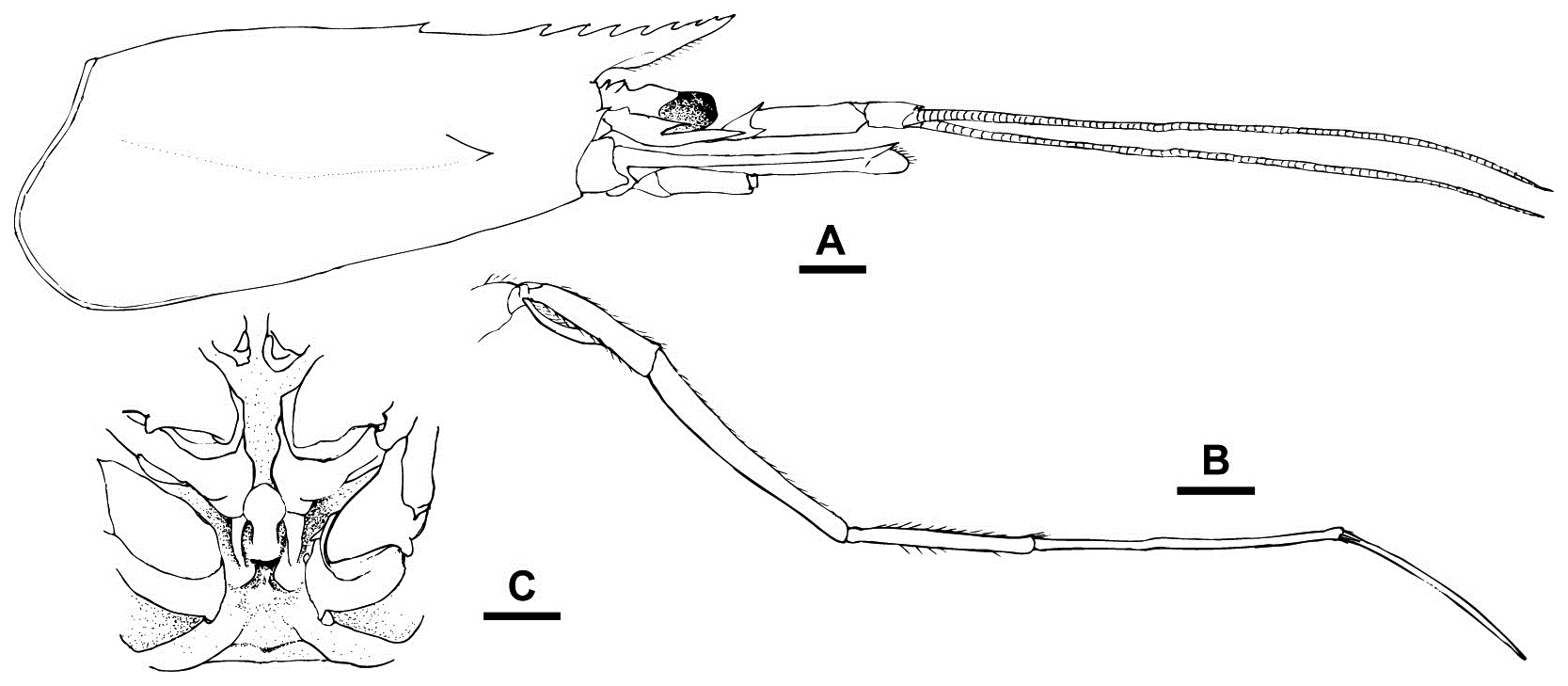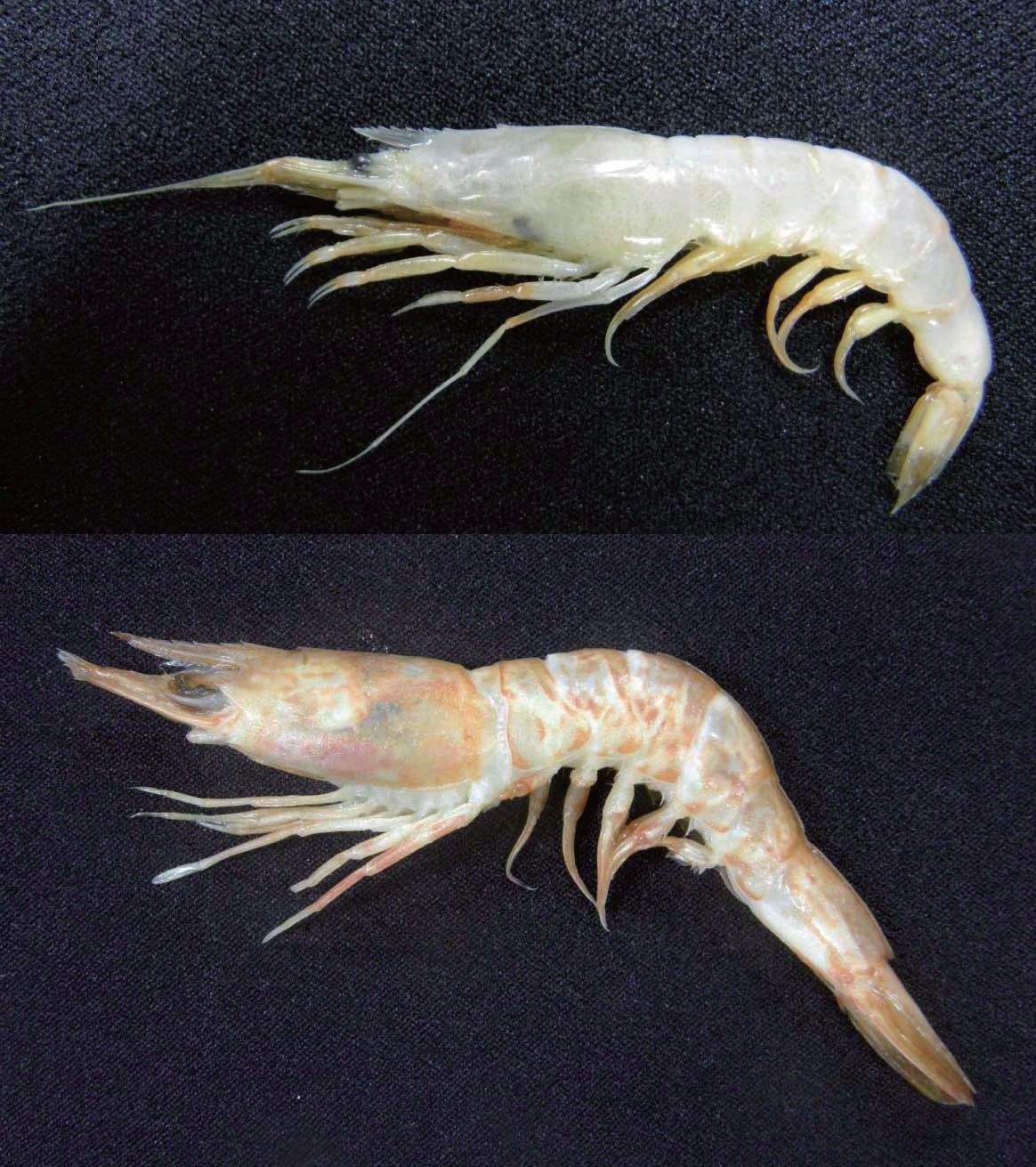



In the family Penaeidae, which includes many commercially important species, 220 species in 32 genera have been reported worldwide (De Grave and Fransen, 2011). Korean penaeid shrimp comprise 18 species in 10 genera (Sakai and Shinomiya, 2011; Kim, 2012). Recently, the number of species has been continuously increasing in Korean waters (Kim et al., 2002, 2003, 2007). During the course of a taxonomic study on decapod crustaceans, two penaeid species were collected:
The specimens examined were deposited at the Fisheries Resource Management Division, National Fisheries Research and Development Institute (NFRDI). Postorbital carapace length (CL) is used as a standard length of the specimens for measurements, and the terminology generally follows Pérez Farfante and Kensley (1997).
Family Penaeidae Refinesque-Schmaltz, 1815
Genus Atypopenaeus Alcock, 1905
(new Korean name: Eory-bori-saewoo-sok)
>
Atypopenaeus stenodactylus (Stimpson, 1860) (new Korean name: Eory-bori-saewoo) (
Restricted synonymy
Material examined
Specimens collected off Sacheon, southern coast of Korea at 5-10 m depth by shrimp beam trawl on September 18, 2009: two females (CL 15.7, 16.0 mm), NFRDI-CR 20130531-1.
Description
Integument almost entirely glabrous, with some pubescence in rostral margin (Fig. 1A). Rostrum straight, reaching as far as first segment of antennular peduncle; upper margin straight with seven teeth including three teeth on carapace; epigastric tooth widely separated from first rostral tooth (Fig. 1A). Carapace with minute orbital spine, antennal and hepatic spines well defined; branchiocardiac sulcus feeble (Fig. 1A). Abdomen with middorsal carina on second to sixth somites. Telson without lateral spine. Antennular flagella longer than carapace length, upper and lower flagella subequal in length (Fig. 1A). All pereopods with exopods. First and second pereopods each with ischial spine, second and third pereopods each with basial spine; fifth pereopod slender and very elongate, much longer than preceding ones (Fig. 1B). Thelycum with paired flap-like lateral plates posteriorly flanking deep concavity on sternite XIV; median protuberance on sternite XIII elongate, roughly mushroom shaped, bluntly acute anteriorly (Fig. 1C).
Coloration in freshly preserved specimen
Body pale orange, appendages rather deep orange, integument somewhat transparent (Fig. 3A).
Distribution
Indo-West Pacific: India to Malay Archipelago, Hong Kong, Taiwan, southern Japan, New Guinea, and northern Australia; 10-50 m depth (Yu and Chan, 1986). Southeastern coast of Korea, 5-10 m depth in this study.
Size
Maximum CL 19.0 mm in female (Hayashi, 1992).
Remarks
Korean Penaeidae includes 10 genera,
and
Genus
>
Metapenaeopsis toloensis Hall, 1962 (new Korean name: Nam-bang-kkal-kkal-saewoo) (
Restricted synonymy
Material examined
Specimen collected off Dadaepo, Busan, southern coast of Korea at 24-28 m depth by shrimp beam trawl on August 3, 2010: one female (CL 22.2 mm), NFRDI-CR 20130531-2.
Description
Body tomentous (Fig. 2A and 2B). Rostrum directed slightly upward, reaching distal end of third antenular segment; dorsal margin with seven teeth, distal one minute; epigastric tooth conspicuously separated from first rostral tooth (Fig. 2A). Carapace with small orbital, moderately developed antennal, pterygostomian, hepatic spines; posteroventral part with 15 stridulating ridges (Fig. 2A). Abdomen mid-dorsally carinated from posterior half of second to sixth somites, that of third somite slightly grooved dorsally, those of third and fourth somites incised posteriorly (Fig. 2B). Telson armed with three pairs of movable and one pair of fixed spines in distal half. Thelycum with transverse plate on sternite XIV concave medially, lateral margins expanding anteriorly; anterior margin of median plate on sternite XIII slightly convex; coxal expanding part of fourth pereopod very large (Fig. 2C).
Coloration in freshly preserved specimen
Body pale brown with many purple-red splotches and dark brown stripes; pereopods and pleopods with purple-red splotches (Fig. 3B).
Distribution
Indo-West Pacific: Arabian Sea, Maldive Islands, Sri Lanka, Bay of Bengal, Andaman Sea, Malay Archipelago to Japan, New Guinea, Australia, Chesterfield Islands; 8-73 m depth (Crosnier, 1994). Southeastern coast of Korea, 24-28 m depth in this study.
Size
Maximum CL 24.0 mm in female (Hall, 1962).
Remarks
The genus
Key to Korean Penaeidae genera
1. Rostrum armed with dorsal and usually also ventral teeth. Pleurobranchia on somite XIV (last thoracic somite).......2
– Rostrum usually armed with dorsal teeth only. No pleurobranchia on somite XIV .....................................................5
2. Adrostral sulcus and carina long, reaching far beyond epigastric tooth, usually almost to posterior margin of carapace. Gastrofrontal carina present ......................................3
– Adrostral sulcus and carina short, falling distinctly short or extending to about level of epigastric tooth. Gastrofrontal carina absent ......................................................................4
3. Gastrofrontal sulcus not markedly bifid posteriorly. Thelycum with pair of lateral plates on sternite XIV......
– Gastrofrontal sulcus markedly bifid posteriorly. Thelycum with single plate on sternite XIV infolded laterally ......................................................................
4. Hepatic carina absent or, if present, moderately to ill defined .......................................................
– Hepatic carina prominent ........................................
5. Telson with pair of well developed fixed subapical spines (preceded by lateral movable spines). First segment of antennular peduncle usually bearing ventromesial (parapenaeid) spine ..................................................................6
– Telson without pair of subapical spines, usually with movable lateral spines. First segment of antennular peduncle usually lacking parapenaeid spine .....................................7
6. Carapace with longitudinal suture (extending at least 80% of its length) and transverse suture. Not more than one pair of minute lateral spines anterior to subapical spines. Petasma symmetrical ...........................................
– Carapace without longitudinal suture. Two or more pairs of conspicuous spines anterior to subapical spines. Petasma asymmetrical ..............................................
7. Pleurobranchia on somite XIII (penultimate thoracic somite). Exopods on maxillipeds and four anterior pairs of pereopods, lacking on fifth pereopod ..............
– Pleurobranchia absent on somite XIII. Exopods present on all pereopods or absent from four posterior pairs ............. 8
8. Carapace lacking longitudinal suture. Second pereopod armed with ischial spine ...............................
– Carapace with longitudinal suture. Second pereopod lacking ischial spine ..................................................................9
9. Body thickset, integument thick. Third pereopod with epipod .............................................................
– Body slender, integument thin. Third pereopod lacking epipod ...................................................................................10
10. Distomedian projection of petasma developed into leaflike shape..........................................................
– Distomedian projection of petasma undeveloped ................ .....................................................................


